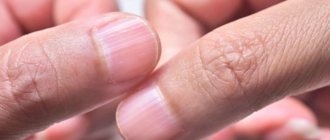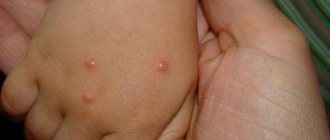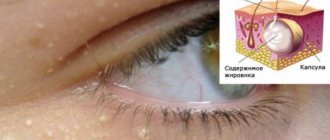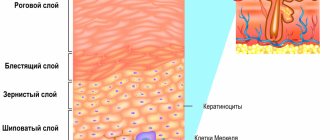How chickenpox begins and develops Chickenpox is an acute infectious disease characterized by a profuse itchy rash on the skin and surface of the mucous membranes. It does not appear instantly: the incubation period can range from 10 days to 3 weeks.
Chickenpox is highly contagious. The virus is transmitted through direct contact with a carrier. Children often get sick in entire groups (groups in kindergarten or classes at school). We will tell you how to recognize the disease in the shortest possible time to prevent its spread.
What causes chickenpox?
The causative agent of this disease is human herpesvirus type 3. It belongs to the subfamily of alphaherpesviruses, which have the following features:
- a wide range of hosts (humans and animals);
- short reproductive cycle;
- rapid reproduction;
- volatility;
- rapid decay of affected cells;
- death under the influence of UV rays.
When the chickenpox virus enters the human body, for the first three to four days it is contained within blisters covering the skin. On the eighth day it ceases to be detected. Outside a living organism, type 3 herpesvirus dies in 15 minutes.
The rash usually appears 48 hours after infection. The carrier remains infectious for another five days. Infection occurs by airborne droplets. Contact-household infection is also possible.
How to recognize chickenpox?
To get sick, two conditions are enough: to be near someone with chickenpox and not have a history of it. Everyone gets infected with it, regardless of age and immunity strength. Nothing can be done during the incubation period. All we have to do is wait for the first signs:
- temperature rise to 38-39 degrees;
- general malaise;
- decreased appetite;
- the appearance of a characteristic rash.
At first, the rash is rare and looks like spots or pimples. Under no circumstances should you squeeze them out: the scar will be very deep. The volume of the rash gradually increases, covering all parts of the body.
In the early stages, chickenpox can be mistaken for an allergic reaction. But contact dermatitis rarely spreads throughout the body and never develops into blisters.
In this case, the person feels severe itching. Scratching chickenpox is also not advisable. This will not bring relief, but there is a risk of getting a lot of scars on the skin or causing a secondary infection.
Tsindol
“Tsindol” for chickenpox perfectly relieves inflammation, disinfects wounds, and dries out burst blisters. The suspension should be used to treat the rash 3-5 times a day, depending on the severity of the condition. "Tsindol" is completely safe, so it is prescribed to children under one year of age and to pregnant women. The only contraindication is intolerance to zinc oxide.
Tsindol
Yaroslavl Pharmaceutical Factory, Russia
Diaper rash, diaper rash, prickly heat, dermatitis, ulcerative skin lesions, superficial wounds, eczema in the acute phase, herpes simplex, streptoderma, trophic ulcers, burns, bedsores.
from 36
556
- Like
- Write a review
Periods of chickenpox
Quite a long time passes between infection with the herpes virus and complete recovery. There are four periods:
- incubation (up to three weeks);
- prodromal (up to two days before the appearance of rashes);
- rashes (several waves for two to five days);
- crust formation.
During the prodromal period, the patient experiences general malaise. It is expressed in weakness, nausea, headache. Sometimes the temperature rises to 38-39 degrees, and vomiting occurs. In some patients, there is no prodromal period, and rashes immediately appear some time after infection.
Chickenpox in adults causes severe complications. They do not appear immediately. Some appear after the tenth day of the disease, others after a month.
Disease prevention
Prevention includes isolating patients at home and introducing quarantine in children's institutions.
To avoid infection, people who have not been sick should avoid contact with sick people. There is also specific prevention of the disease. The chickenpox vaccine in children prevents the disease in 98% of patients who receive the two recommended injections. Vaccination is carried out at the age of 12 - 15 months, revaccination - at 4 - 6 years.
For older children and adults who have not been vaccinated, the chickenpox vaccine can be given at any time to help prevent the disease.
How does chickenpox occur in children?
Chickenpox is considered a childhood disease, since it mainly affects children of preschool and primary school age. In children, the illness period is relatively short (about 10 days), while in adults it can last three weeks or more.
During this time, the rash goes through several stages:
- erythematous spots;
- nodular rash (papule);
- ulcers (pustules);
- crusts.
Recovery occurs when all the scabs fall off. Until this point, the person is still contagious and can pass the chickenpox virus to others. The first wave of rashes usually passes quickly, but it is replaced by several more.
As a rule, there are no complications in children. The main thing is that the baby does not scratch the rash to avoid secondary infection and scar formation. Severe disease occurs in newborns. When the first signs of chickenpox appear in an infant, you should immediately call a doctor.
Cetirizine
Doctors often prescribe Cetirizine (Zyrtec) for chickenpox. For children - in drops, for adults - in tablets. The drug relieves symptoms well in itchy allergic dermatoses, has no contraindications and is usually well tolerated.
Cetirizine
JSC VERTEX, Russia
seasonal and year-round allergic rhinitis and conjunctivitis (itching, sneezing, rhinorrhea, lacrimation, conjunctival hyperemia);
urticaria (including chronic idiopathic urticaria); hay fever (hay fever); itching; angioedema (Quincke's edema); itchy allergic dermatoses. from 36
540
- Like
- Write a review
Atypical forms of chickenpox in adults
In adults, chickenpox is accompanied by symptoms of intoxication of the body. Atypical clinical forms are also possible:
- Rudimentary. The rash is either absent or does not develop beyond the blotchy stage.
- Hemorrhagic. A bloody impurity appears in the blisters, and small hemorrhages appear on unaffected areas of the skin. Black crusts form.
- Bullous. Along with the usual chickenpox, other blisters appear. They are filled with a cloudy yellowish liquid and take a long time to dry. If such blisters burst prematurely, the area of skin underneath them becomes wet for a long time and does not heal.
- Gangrenous. The tissues inside the blisters die, and ulcers form underneath them. Cleaning of pus is often required.
The generalized form of chickenpox is considered separately. It is characterized by damage to internal organs. It is difficult to tolerate and there are deaths. At risk are patients taking steroid hormones.
How to help with chickenpox?
There is currently no cure for chickenpox. Usually the disease goes away on its own, and therapy is limited to smearing the rash with aniline dyes with bactericidal properties. A solution of brilliant green (“zelenka”) is usually used. You can take an antipyretic to relieve your general condition.
To relieve itching use:
- solution of iodine tincture (2-3%);
- solution of potassium permanganate (1:5000);
- hydrogen peroxide (3%);
- glycerol.
In some cases, antihistamines can help relieve itching. But you should not take them uncontrollably: it is better to call a doctor at home and determine acceptable medications. Showering is allowed, but without a washcloth to avoid damaging the bubbles. The same applies to the use of towels - after water procedures, you need to carefully pat your body dry with a cloth.
Chlorhexidine
"Chlorhexidine" (or its analogue "Miramistin") for chickenpox is applied to the vesicles 2-3 times a day. The product is also suitable for rinsing your mouth. "Chlorhexidine" is a broad-spectrum antiseptic with antimicrobial and antifungal effects.
Chlorhexidine
Update, Russia
Prevention of sexually transmitted infections (chlamydia, ureaplasmosis, trichomoniasis, gonorrhea, syphilis, genital herpes).
Disinfection of purulent wounds, infected burn surfaces; treatment of infections of the skin and mucous membranes in surgery, obstetrics and gynecology, urology (urethritis, urethroprostatitis), dentistry (gingivitis, stomatitis, aphthae, periodontitis, alveolitis). from 12
1060
- Like
- Write a review
Complications of chickenpox
In most cases, this disease is not dangerous; children tolerate it easily. The only threat is infection of the wound when combing with dirty hands. In such cases, staphylococci or streptococci may be ingested and a purulent infection may develop.
The chickenpox virus does not disappear from the body after recovery. Temporarily neutralized, it is localized in the spinal cord. As years pass, it can become more active and cause shingles.
In adults, complications may include:
- stomatitis (if a rash appears in the mouth);
- conjunctivitis (on the eyelids);
- inflammation of the middle ear.
The greatest danger is chickenpox pneumonia with a mortality rate of 40%. The consequences of infection with the chickenpox virus can manifest themselves in the form of neurological disorders, heart disease, and joint damage. A month after recovery, there is a risk of developing retinal inflammation and cranial nerve palsy.
Rivanol
"Rivanol" is an antiseptic for external use in the form of a solution, effective in combating mainly coccal microorganisms (streptococci, staphylococci). It is these bacteria that usually cause complications with chickenpox (carbuncles, boils). "Rivanol" is used to spot treat ulcers 3-3 times a day. Contraindications: kidney problems and pregnancy.
Rivanol 0.1%
Dina+, UK
Rivanol is an antiseptic, has antimicrobial activity, fights coccal microorganisms, and is used in gynecology, urology, surgery, dermatology, and ophthalmology.
from 146
117
- Like
- Write a review
What is chickenpox pneumonia?
This is a lung lesion that occurs in 16% of cases of chickenpox and in almost all cases if the disease occurs in a generalized form. The first symptoms may appear simultaneously with the rash:
- dyspnea;
- chest pain;
- cough with sputum (often with blood);
- bluishness of the skin.
Multiple focal nodules spread in the lungs, which on x-ray look like tuberculosis. Antibiotics do not help in this case. Against the background of chickenpox pneumonia, bronchitis often develops; in severe cases, pulmonary edema is possible.
Pneumonia that develops in the later stages of chickenpox is considered separately. It is caused by a secondary coccal infection and is a common pneumonia. The disease is treated according to the standard regimen - penicillin.
Furacilin
Wounds with chickenpox should be treated with a 0.02% solution of Furacilin 3-4 times a day (it is better to use a cotton pad). The product relieves inflammation, kills germs, and dries wounds well. "Furacilin" can also be used for ulcers on the mucous membranes.
Furacilin solution
Samaramedprom OJSC, Russia; PJSC "Biosintez", Russia; JSC Dalkhimfarm, Russia; Vips-Med, Russia
Externally: purulent wounds, bedsores, stage II – III burns, minor skin damage (including abrasions, scratches, cracks, cuts).
Locally: blepharitis, conjunctivitis, boil of the external auditory canal; osteomyelitis, empyema of the paranasal sinuses, pleura (washing the cavities); acute external and otitis media, tonsillitis, stomatitis, gingivitis. from 36
5.0 2 reviews
76
- Like
- Write a review
Neurological complications of chickenpox
The consequence of infection with a herpes virus in an adult can be secondary encephalitis. Inflammation develops from the fifth to tenth day of the rash, sometimes even after recovery. The pathological process can be localized in different places:
- membranes of the brain (meningitis form);
- cerebellum (atactic form);
- spinal cord (myelitic form).
- Combined damage to the brain and spinal cord (encephalomyelitis, meningoencephalitis) is also possible.
In mild cases, damage to the central nervous system by the chickenpox virus leads to loss of coordination, involuntary eye movements, hand tremors, and dizziness. In more severe cases, vision suffers (up to its complete loss). The most dangerous complication is paralysis. Mental damage, even mental retardation, is also possible.











